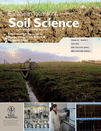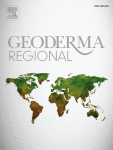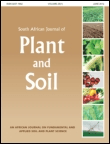
EUROPEAN JOURNAL OF SOIL SCIENCE
Scope & Guideline
Pioneering Research in Soil Ecology and Management
Introduction
Aims and Scopes
- Soil Health and Functionality:
Research on the biological, chemical, and physical properties of soils that contribute to their health and functionality. This includes studies on soil organic matter, microbial communities, and nutrient cycling. - Soil Management Practices:
Investigations into various soil management strategies aimed at improving soil quality, enhancing productivity, and mitigating environmental impacts, such as carbon sequestration and nitrogen management. - Impact of Climate Change on Soils:
Studies exploring how climate change affects soil properties, processes, and functions, including impacts on soil moisture, temperature, and greenhouse gas emissions. - Soil-Plant Interactions:
Research focusing on the interactions between soils and plants, including nutrient uptake, root-soil dynamics, and the role of soil amendments in enhancing plant growth. - Soil Mapping and Modeling:
Development and application of innovative techniques for soil mapping, modeling soil processes, and predicting soil behavior under various management and environmental scenarios. - Soil Contamination and Remediation:
Studies addressing the contamination of soils with heavy metals, pesticides, and other pollutants, as well as strategies for soil remediation and restoration.
Trending and Emerging
- Sustainable Soil Management:
There is an increasing emphasis on sustainable practices that balance productivity with environmental protection, including studies on cover crops, reduced tillage, and organic amendments. - Soil Carbon Sequestration:
Research focused on strategies for enhancing soil carbon storage as a means to mitigate climate change is gaining traction, including studies on biochar, organic matter inputs, and management practices. - Microbial Ecology and Functionality:
Emerging studies on soil microbial communities and their roles in nutrient cycling, soil health, and ecosystem services are becoming more prominent, reflecting a growing interest in soil biology. - Soil-Climate Interactions:
Research exploring the interactions between soil processes and climate variables, particularly in the context of climate change impacts on soil health and function, is increasingly prevalent. - Innovative Soil Mapping Technologies:
The application of advanced technologies such as remote sensing, machine learning, and spectroscopy for soil mapping and analysis is on the rise, indicating a shift towards data-driven approaches. - Soil Contamination and Remediation Strategies:
With growing concerns about soil pollution, there is a trend towards research on contamination sources, impacts, and effective remediation techniques to restore soil health.
Declining or Waning
- Traditional Soil Fertility Studies:
Research focused on basic soil fertility parameters, such as pH and macronutrient levels, has decreased as more complex interactions and innovative management practices gain interest. - Soil Physics without Contextual Applications:
Papers solely focusing on theoretical aspects of soil physics without direct applications to agricultural or environmental contexts have become less common, as applied research gains prominence. - Historical Soil Studies:
Research concentrating solely on historical soil profiles or ancient soil use without contemporary relevance is declining, as the focus shifts to current challenges and sustainability.
Similar Journals

CANADIAN JOURNAL OF SOIL SCIENCE
Advancing Soil Knowledge for a Sustainable FutureThe Canadian Journal of Soil Science (ISSN: 0008-4271, E-ISSN: 1918-1841) is a premier publication in the field of soil science, proudly published by Canadian Science Publishing. Established in 1974, this esteemed journal aims to promote high-quality research and insights into the dynamic interactions within soil ecosystems, addressing pressing issues such as soil health, management, and sustainability. With an impressive 2023 category quartile ranking of Q2 in Soil Science and a Scopus ranking placing it in the 52nd percentile, this journal stands out as a key resource for researchers, professionals, and students alike. Although currently not open access, the journal provides valuable content that contributes to advancing the understanding of soil science, an essential discipline for agricultural innovation and environmental stewardship. As we approach its converged years through 2024, the Canadian Journal of Soil Science is poised to continue its pivotal role in disseminating impactful research and fostering a community dedicated to soil science excellence.

Soil & Environment
Unveiling Pioneering Research in Soil and EnvironmentSoil & Environment is a distinguished open access journal published by the University of Agriculture, Institute of Soil & Environmental Sciences, located in Faisalabad, Pakistan. Established in 2006, this journal has become a vital platform for disseminating pioneering research in the fields of Environmental Science and Soil Science. With an ISSN of 2074-9546, it provides a wealth of knowledge through accessible academic articles, particularly focusing on sustainable practices and innovations that impact soil and environmental health. Although currently categorized in Q4 within both Environmental Science (miscellaneous) and Soil Science, the journal is dedicated to enhancing its influence and visibility as it progresses towards convergence years that span from 2010 to 2024. Researchers, professionals, and students will find Soil & Environment an essential resource for staying informed about the latest developments and methodologies in soil conservation and environmental sustainability. By offering publicly accessible content, the journal aims to foster greater collaboration and knowledge-sharing within the global scientific community.

EGYPTIAN JOURNAL OF SOIL SCIENCE
Cultivating Knowledge in Soil Management and ConservationEGYPTIAN JOURNAL OF SOIL SCIENCE is a renowned publication dedicated to advancing the field of soil science, particularly within the context of Egypt and the broader regions of the Middle East and North Africa. Published by the NATIONAL INFORMATION DOCUMENTATION CENTER, ACADEMIC SCIENTIFIC RESEARCH & TECHNOLOGY, this journal aims to disseminate high-quality research and innovative practices related to soil management, conservation, and sustainable agricultural practices. With an emphasis on empirical studies, reviews, and methodologies relevant to soil health and productivity, this journal serves as an essential resource for researchers, professionals, and students alike. Although specific access options are not highlighted, the journal’s commitment to promoting scholarly discourse ensures that important findings within soil science are made available to wider audiences, contributing significantly to environmental science, agronomy, and ecological preservation.

Soil Research
Exploring the vital role of soil in our ecosystem.Soil Research, published by CSIRO PUBLISHING, is an esteemed scholarly journal dedicated to advancing the field of soil science, environmental science, and earth-surface processes. With an ISSN of 1838-675X and E-ISSN of 1838-6768, this journal serves as a vital platform for researchers and professionals to disseminate innovative findings and engage with contemporary challenges in soil and environmental management. The journal is recognized for its impactful contributions, as evidenced by its Q2 ranking in 2023 across multiple categories including Earth-Surface Processes, Environmental Science, and Soil Science, reflecting its influence and relevance in these critical academic areas. Operating from its headquarters in Clayton, Victoria, Australia, Soil Research is committed to fostering open access to research, ensuring wider dissemination of knowledge. As it converges toward its future objectives until 2024, the journal aims to provide a forum for diverse perspectives that enhance understanding and stewardship of soil resources, making it an indispensable resource for students, researchers, and industry professionals alike.

Geoderma Regional
Connecting research and practice in soil science.Geoderma Regional is a premier scholarly journal dedicated to advancing the field of Soil Science. Published by Elsevier in the Netherlands, this journal serves as a vital platform for disseminating high-quality, peer-reviewed research that spans the complexities of soil management, behavior, and the implications of soil processes on environmental sustainability. Since its inception in 2014, Geoderma Regional has achieved an impressive position within the academic community, holding a Q1 ranking in the field of Soil Science, placing it among the top 20% of journals in its category according to SCOPUS rankings. This journal is particularly distinguished for its significant contributions to the nexus between agriculture and biological sciences, reflected in its rank of #33 out of 159 in this field with a commendable 79th percentile. Researchers, professionals, and students alike will appreciate the journal's commitment to open discourse and innovative research agendas as it aspires to enhance our understanding of soil dynamics, addressing critical issues facing our planet.

SOIL SCIENCE AND PLANT NUTRITION
Exploring the vital connections between soil and plant health.SOIL SCIENCE AND PLANT NUTRITION, published by Taylor & Francis Ltd, stands as a prominent journal in the fields of plant science and soil science, with its impact reflected in its Q2 ranking across both categories in 2023. Established in 1955, this journal provides a vital platform for researchers, professionals, and students dedicated to understanding the complex interactions between soil and plant nutrition, with an emphasis on advancing sustainable agricultural practices. With an impressive Scopus ranking, placing it in the 75th percentile for Plant Science and the 71st for Soil Science, it attracts high-quality, peer-reviewed articles that contribute significantly to the body of knowledge in these disciplines. While the journal does not currently offer Open Access options, its comprehensive scope encompasses studies from fundamental research to applied science, making it an essential resource for anyone engaged in soil management, agronomy, or related fields.

BIOLOGY AND FERTILITY OF SOILS
Pioneering Discoveries in Soil Health and ManagementBIOLOGY AND FERTILITY OF SOILS, published by Springer, is a leading international journal dedicated to advancing the field of soil science with a focus on the intersection of biological processes and fertility management. With its ISSN 0178-2762 and E-ISSN 1432-0789, this journal serves as a key resource for researchers and professionals alike, reflecting its esteemed status in the community, evidenced by its Q1 rankings in Agronomy and Crop Science, Microbiology, and Soil Science. Covering a broad range of topics from soil health to sustainable agricultural practices, the journal's significant impact factor underscores its critical role in driving innovative research in the domain. While not offering Open Access options, it features rigorous peer-reviewed research that spans decades, converging influential studies from 1985 to 2024. Located in Germany with offices in the United States, the journal maintains a strong international presence, providing insights that enhance the understanding and management of soil ecosystems crucial for sustainable agriculture. Researchers aiming to expand their knowledge on soil biology and fertility will find this journal an invaluable asset.

Biochar
Transforming Sustainability Through Biochar InnovationWelcome to Biochar, an esteemed academic journal dedicated to the exploration and advancement of biochar technology and its applications across multiple fields. Published by SPRINGER SINGAPORE PTE LTD, this journal serves as a vital platform for disseminating high-quality research that addresses the critical intersection of environmental science, soil health, and sustainable materials development. With a commendable Q1 ranking in the fields of Biomaterials, Environmental Science, Pollution, and Soil Science, Biochar is recognized for its significant impact, as evidenced by its placement in the upper percentiles across various Scopus rankings. Researchers and professionals in agricultural and biological sciences will find valuable insights and innovative methodologies that promote sustainable practices and enhance soil quality. This journal, operating from its base in Germany, is committed to fostering a collaborative environment where cutting-edge research can inform policy and practice. Engage with us as we strive to advance the science of biochar from 2019 to 2024 and beyond.

Spanish Journal of Soil Science
Empowering Global Collaboration in Soil ResearchThe Spanish Journal of Soil Science is a prestigious open-access journal published by FRONTIERS MEDIA SA since 2011. Based in Switzerland, this journal serves as a vital platform for disseminating innovative research and applications within the field of soil science. With its commitment to accessibility, the journal enables researchers, professionals, and students from around the globe to contribute to and benefit from its wealth of knowledge. As of 2023, it holds a respectable Q3 category ranking in soil science and is positioned at #88 out of 159 in the Scopus rankings for Agricultural and Biological Sciences. The journal aspires to foster collaboration and communication among soil scientists, encouraging the exploration of contemporary soil issues, sustainable practices, and advancements in technology. Its open-access model ensures that the latest findings are freely available, promoting a broader impact in environmental and ecological studies.

South African Journal of Plant and Soil
Championing excellence in plant and soil research.South African Journal of Plant and Soil is an esteemed academic publication dedicated to advancing the fields of Ecology, Plant Science, and Soil Science. Published by TAYLOR & FRANCIS LTD in the United Kingdom, this journal has been a vital resource since its inception in 1984, providing a platform for innovative research and scholarly articles that address critical issues in plant and soil management. With a current impact factor placing it in the Q3 category according to the 2023 rankings, it occupies an influential position within the academic community, especially amongst researchers focused on agricultural and environmental sciences. Although not an open-access journal, it remains accessible to a broad audience through libraries and institutions that recognize its value in facilitating ecologically and environmentally focused discussions. The journal's ongoing commitment to publishing high-quality research ensures that it plays a pivotal role in nurturing knowledge and fostering advancements in sustainable practices across southern Africa and beyond.